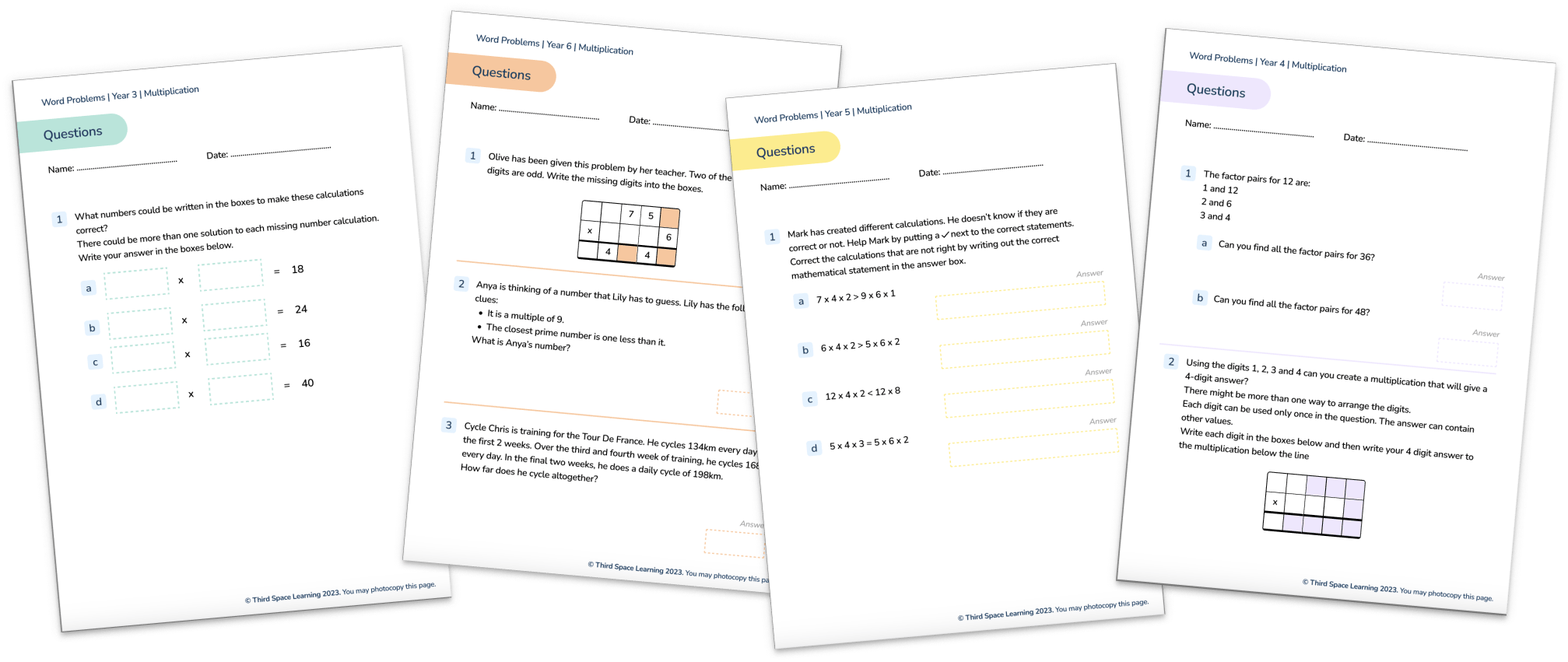18 Word Problems For Year 5: Develop Their Problem Solving Skills Across Single and Mixed KS2 Topics
Word problems for Year 5 are a great way to assess pupils’ number fluency. By the time primary school children reach Upper Key Stage 2, they will be building on their knowledge and understanding of the number system and place value, working with larger integers. An increased understanding of the connections between the different maths concepts is crucial, as children will be expected to tackle more complex, multi-step problems.
It is important children are regularly provided with the opportunity to solve a range of word problems and Year 5 maths worksheets with reasoning and problem solving incorporated alongside fluency, into all lessons.
To help you with this, we have put together a collection of 18 word problems aimed at Year 5 maths pupils.
- Year 5 maths word problems in the national curriculum
- Why are word problems important in Year 5 maths?
- How to teach problem solving in Year 5
- Addition word problems for Year 5
- Subtraction word problems for Year 5
- Multiplication word problems for year 5
- Division word problems for year 5
- Fraction and decimal word problems in Year 5
- Mixed four operation word problems
- Word problem resources
All Kinds of Word Problems
Download this free pack of multiplication word problems to help your Year 5 class grow their problem solving skills
Download Free Now!Year 5 maths word problems in the national curriculum
The National Curriculum states that by Year 5, pupils should develop their ability to solve a wider range of problems, including increasingly complex properties of numbers and arithmetic, and problems demanding efficient written and mental methods of calculation. Children also begin to use the language of algebra for solving a range of problems.
By Year 5, pupils should be starting to gain confidence in solving more complex two-step and multi-step word problems, covering topics across the Year 5 curriculum.
Place value
Solve number and practical problems involving ordering and comparing numbers to at least 1,00,000; counting forwards or backwards in steps of powers of 10; interpreting negative numbers in context and rounding to the nearest 10,100, 1000, 10,000 and 100,000.
Addition and subtraction
Solve addition and subtraction word problems and a combination of these, including understanding the meaning of the equals sign.
Multiplication and division
Solve problems involving multiplication and division, including using knowledge of factors, multiples, squares and cubes and scaling by simple fractions.
Fractions, decimals and percentages
Solve problems involving numbers up to 3 decimal places and problems which require knowing percentage and decimal equivalents.
Measurement
Solve time word problems and those involving converting between units of time and problems involving measure (for example, length, mass, volume and money word problems) using decimal notation and scaling.
Statistics
Solve comparison, sum and difference problems, using information presented in a line graph.

Meet Skye, the voice-based AI tutor making maths success possible for every student.
Built by teachers and maths experts, Skye uses the same pedagogy, curriculum and lesson structure as our traditional tutoring.
But, with more flexibility and a lower cost, schools can scale online maths tutoring to support every student who needs it.
Watch Skye in actionWhy are word problems important in Year 5 maths?
Word problems are an important element of the Year 5 curriculum. By this stage, children need to be building confidence in approaching a range of one, two and multi-step word problems. They require children to be creative and apply the skills they have learnt to a range of real-life situations.
How to teach problem solving in Year 5
Children need to be taught the skills for successfully approaching and tackling word problems. Reading the question carefully and identifying the key information needed to tackle the problem, is the first step, followed by identifying which calculations are required for solving it and deciding whether it will be helpful to draw a picture/ visual representation to understand and answer the question.
Using mental maths skills to round and estimate an answer is also very helpful for children to establish whether their final answer is realistic. Children need to also be able to calculate the inverse, to be able to check their answer, once the problem has been completed.
See also: Mental maths year 5
Here is an example:
A transport museum has 1243 visitors on Monday morning and another 1387 visitors in the afternoon. On Tuesday 736 fewer visitors go to the museum than who visited on Monday.
How many visitors were there altogether on Tuesday?
How to solve:
What do you already know?
- The number of visitors on Monday morning and Monday afternoon are given separately. They need to be added together to give the total number of visitors for Monday.
- ‘Fewer’ means I will need to subtract the number of fewer visitors on Tuesday from the total number of visitors on Monday.
- Column addition and subtraction will be needed to solve this question.
How can this be drawn/represented pictorially?
We can draw a bar model to represent this problem:
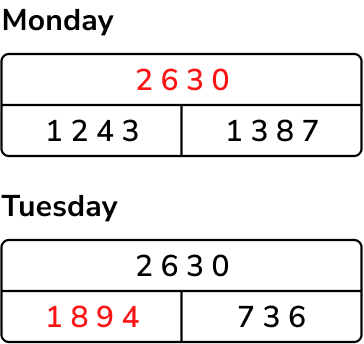
- To calculate the total number of visitors on Monday, we need to add 1243 and 1387 together. 1243 + 1387 = 2630
- The number of fewer visitors on Tuesday needs to be subtracted from Monday’s total: 2630 – 736 = 1894.
- The total number of visitors on Tuesday was 1894.
Addition word problems for Year 5
In Year 5, addition word problems can involve whole numbers with over 4 digits and decimal numbers. Children should be able to round number to check the accuracy and begin to solve two step number problems
Addition question 1
Gemma picks two cards from the cards below and adds them together.
She is able to make three different totals. What will they be?
2365 6281 9782
Answer (2 marks): 12,147 16,063 8646

Addition question 2
Ahmed adds two of these numbers mentally.
357 280 294 232
In his calculation, he exchanges twice to create one ten and one hundred.
Write Ahmed’s calculation and work out the total.
Answer (1 mark): 357 + 294 = 651
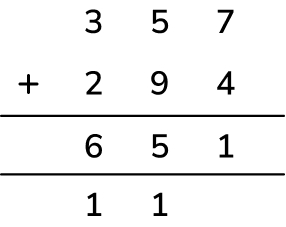
Addition question 3
Change one digit in the calculation below, so that the answer is a multiple of 10.
726 + 347
Answer (1 mark): 723 + 347 = 1070
Subtraction word problems for Year 5
Subtraction word problems in Year 5 require pupils to be confident subtracting numbers over 4 digits and problems involving decimal numbers. Pupils need to be able to round numbers to check accuracy and to use subtraction when solving mixed word problems.
Subtraction question 1
A coach is travelling 4924 km across the USA
It has 2476 km to go.
How many kilometres has the coach already travelled?
Answer (1 mark): 2448 km
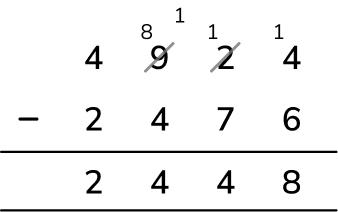
Subtraction question 2
A primary school printed 7283 maths worksheets in the Summer term. 2156 were for Key Stage 1 pupils. How many were printed for Key Stage 2?
Answer (1 mark): 5127 worksheets
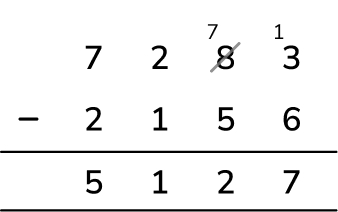
Subtraction question 3
A clothing company made £57,605 profit in 2021 and £73,403 in 2022.
How much more profit did the company make in 2022 than in 2021?
Answer (1 mark): £15,798
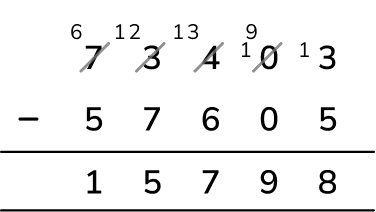
Multiplication word problems for year 5
In year 5, multiplication word problems include problems involving times tables and multiplying whole numbers up to 4-digits by 1 or 2-digit numbers. Pupils also need to be able to combine multiplication with other operations, in order to solve two-step word problems.
Multiplication question 1
In this diagram, the numbers in the circles are multiplied together to make the answer in the square between them.
Complete the missing numbers.
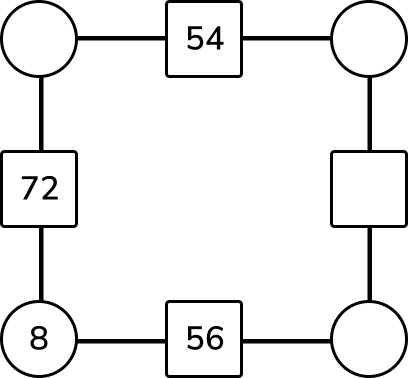
Answer (1 mark)

Multiplication question 2
Mrs Jones was printing the end of year maths test. Each test had 18 pages and 89 pupils were sitting the test. Mrs Jones also needed to print out 12 copies for the teachers and Teaching Assistants who were helping to run the test.
How many pieces of paper did Mrs Jones need to put in the photocopier, to make sure she had enough for all the tests?
Answer (1 mark)
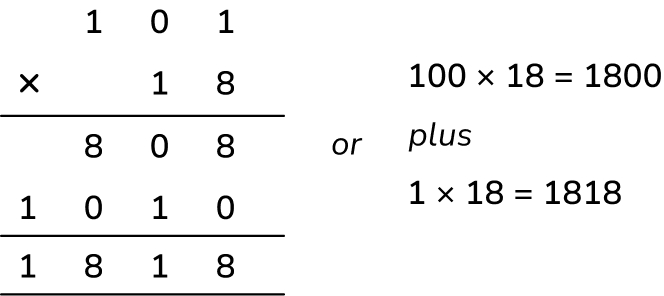
Multiplication question 3
A school is booking a trip to Alton Towers. Tickets cost £22 per pupil.
There are 120 children in each year group and all the children from 3 year groups will be going.
What will be the total price for all the tickets?
Answer (2 marks): £7920
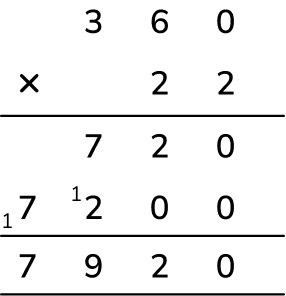
Third Space Learning often ties word problems into our AI maths tutoring. Each lesson is personalised to the needs of the individual student and delivered by Skye, the AI maths tutor, to grow pupils’ maths knowledge and problem solving skills.
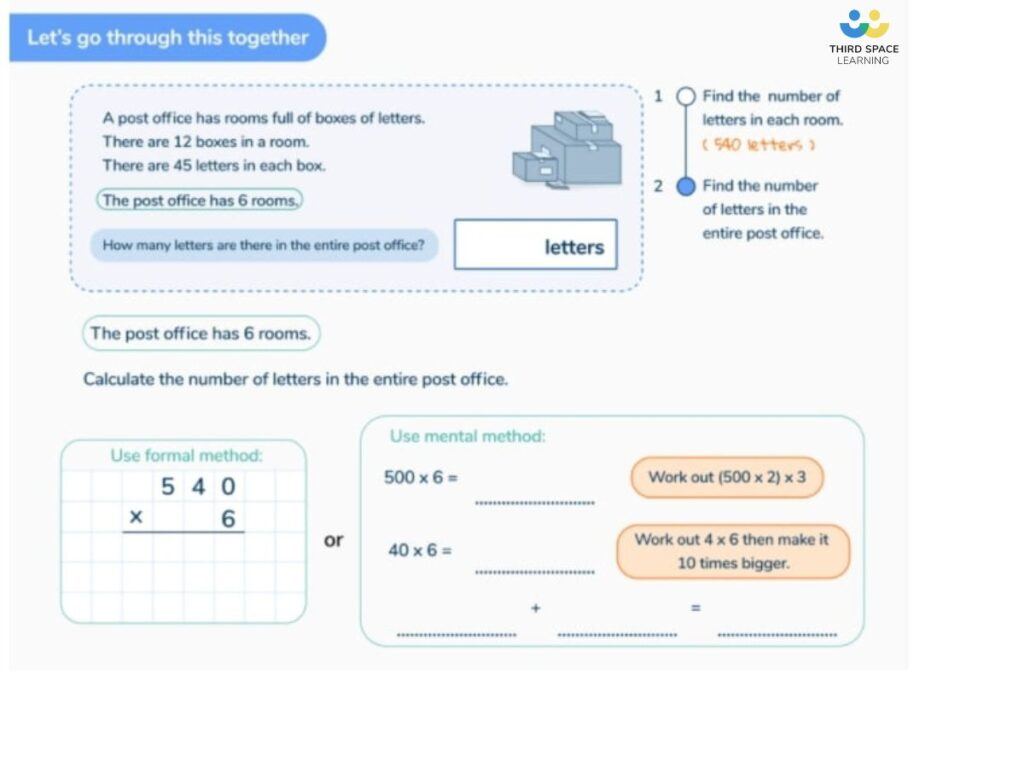
Division word problems for year 5
In Year 5, division word problems can involve whole numbers up to 4 digits being divided by 1-digit numbers. Pupils need to understand how to answer word problems, when the answer involves a remainder.
Division question 1
Tom has 96 cubes and makes 12 equal towers.
Masie has 63 cubes and makes 9 equal towers.
Whose towers are tallest and by how many cubes?
Answer (2 marks): Tom
Tom’s tower has more cubes. His towers have 1 more cube than Maise’s towers.
96 ÷ 12 = 8
63 ÷ 9 = 7
Division question 2
A cake factory has made cakes to deliver to a large event.
265 cakes have been baked. How many boxes of 8 cakes can be delivered to the event?
Answer (2 marks): 33 boxes
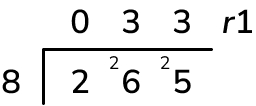
Division question 3
Lily collected 1256 stickers. She shared them between her 8 friends. How many stickers did each friend get
Answer (1 mark): 157 stickers
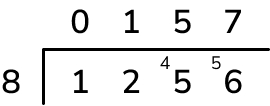
Fraction and decimal word problems in Year 5
In Year 5, fractions word problems and decimals can include questions involving ordering, addition and subtraction of fractions. They can also involve converting between fractions and decimals.
Fraction and decimal question 1
Isobel collected 24 conkers.
She gave \frac{1}{8} of the conkers to her brother.
How many conkers did she have left?
Answer (1 mark): 21 conkers left
\frac{1}{8} of 24 = 3
24 – 4 = 21
Fraction and decimal question 2
Ahmed counted out 32 sweets. He gave \frac{1}{4} of the sweets to his brother and \frac{3}{8} of the sweets to his friend.
How many sweets did he have left?
Answer (2 marks): 12 sweets
\frac{1}{4} of 32 = 8
\frac{3}{8} of 32 = 12
He gave away 20 sweets, so had 12 left for himself.
Fraction and decimal question 3
Two friends shared some pizzas, 1 ate 1 \frac{1}{2} pizzas, whilst the other ate \frac{5}{8} of a pizza. How much did they eat altogether?
Answer (1 mark): 2 \frac{1}{8} of pizza
1 \frac{1}{2} = \frac{12}{8}
\frac {12}{8} + \frac{5}{8} = \frac{17}{8} = 2 \frac{1}{8} pizzas
Mixed four operation word problems
Problems with mixed operations, or ‘multi-step’ word problems, require two or more operations to solve them. A range of concepts can be covered within mixed problems, including the four operations, fractions, decimals and measures. These are worth more marks than some of the more straightforward, one-step problems.
Mixed operation question 1
At the cake sale, Sam buys 6 cookies and a cupcake . He pays £2.85 altogether.
Naya buys 2 cookies and pays 90p altogether.
How much does the cupcake cost?
Answer (2 marks): 60p for one cupcake
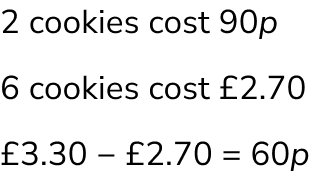
Mixed operation question 2
Large biscuit tin – 48 biscuits (picture of boxes here)
Small biscuit tin – 30 biscuits
Ben bought 2 large tins of biscuits and 3 small tins.
How many biscuits did he buy altogether?
Answer (2 marks): 186 biscuits
2 x 48 = 96
3 x 30 = 90
96 + 90 = 186 biscuits
Mixed operation question 3
The owner of a bookshop bought a box of 15 books for £150.
He sold the books individually for £12 each.
How much profit did he make?
Answer (2 marks)
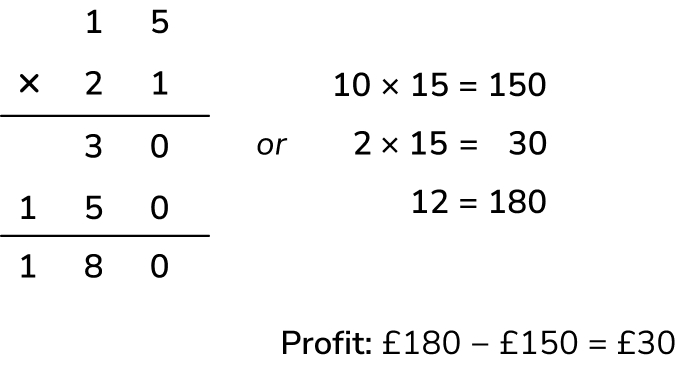
Word problem resources
Third Space Learning offers a wide array of maths and word problems resources for other year groups such as word problems for year 6, word problems for year 3 and word problems for year 4. Our word problem collection covers all four operations and other specific maths topics such as ratio word problems and percentage word problems.
DO YOU HAVE STUDENTS WHO NEED MORE SUPPORT IN MATHS?
Skye – our AI maths tutor built by teachers – gives students personalised one-to-one lessons that address learning gaps and build confidence.
Since 2013 we’ve taught over 2 million hours of maths lessons to more than 170,000 students to help them become fluent, able mathematicians.
Explore our AI maths tutoring or find out about a primary school maths tutor for your school.



